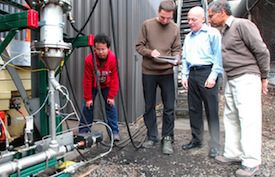President Obama recently unveiled a national Climate Action Plan to “cut carbon pollution, protect our country from the impacts of climate change, and lead the world in a coordinated assault on a changing climate.” A key plan component is directing the Environmental Protection Agency (EPA) to work with states and businesses to reduce carbon pollution from power plants.
SRI International is developing several technologies to capture carbon dioxide generated by burning hydrocarbons such as coal or natural gas at power plants. Once captured, the carbon dioxide can be used or sequestered.

I’m frequently asked which of SRI’s carbon capture technologies is “best.” This question makes no more sense than asking which single pair of shoes would be “best” for a life full of activities as diverse as backpacking and ballroom dancing. We need more than one way to address climate change—and SRI’s scientists are working to give industry desirable options.
In 2011, about 42 percent of the electricity generated in the U.S. came from coal. Most power plants burn coal to boil water that runs steam turbines and generates electricity. In the future, new types of power plants, such as integrated gasification combined cycle (IGCC) plants that gasify coal, may become more prevalent, as engineers develop more environmentally friendly routes to generate electricity from coal. While electricity from natural gas produces far less carbon dioxide (CO2) than electricity from coal, in the future, it may also become necessary to capture emissions from natural gas-powered plants. Each of these scenarios may require different types of carbon capture systems.
Even when focused on a single generation of power plants, the best solution for a particular location may vary with plant size, the type of coal used, the local regulatory environment, local CO2 markets, financing considerations, or other factors, such as business models. One of SRI’s capture projects involves helping a client scale up a technology to recover CO2 from air. While recovering CO2 from a dilute stream can be costly, if the CO2 can be produced near a location that needs CO2, then the savings in transportation costs may make up for the cost of recovery.
Several SRI scientists are at the National Energy Technology Laboratory’s annual CO2 Capture Technology Meeting in Pittsburgh, Pennsylvania from July 8-12, 2013. Dr. Gopala Krishnan presented Development of Advanced Carbon Sorbents for CO2 Capture. Today, he posits, carbon sorbent-based technology may make economic sense at chemical operations and other locations where CO2 is produced and consumed.
In July, Chemical Engineering magazine profiled a new “mixed salt” approach under development in a program led by SRI’s Dr. Indira Jayaweera. Her approach, which shows promise for use at large power plants, leverages the advantages of ammonia-based approaches (high CO2 loadings, regeneration at high pressure) with more environmentally friendly systems based on potassium carbonate.
Please contact us or visit our web page for more information on the full slate of technologies we are developing through our own research, in partnership with clients, or on behalf of clients. These technologies offer the promise of technology leadership for the U.S. and real impact on reducing CO2 in the atmosphere.


